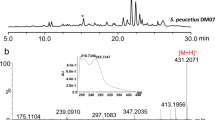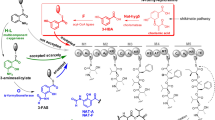Abstract
Kedarcidin and neocarzinostatin belong to the chromoprotein family of endiyene antibiotics and have potent antitumor activity. Their structures consist of an apoprotein and a nonpeptide chromophore. Apoprotein has been known to be essential to stabilize and regulate the availability of a labile chromophore. Here, we have identified the complete kedarcidin apoprotein gene (kedA) from Streptoalloteichus sp. ATCC 53650 (Actinomycete L585-6). KedA was characterized by a comparative study with neocarzinostatin apoprotein (NcsA). Overexpression of kedA resulted in a ∼ 2-fold enhanced production of kedarcidin in Streptoalloteichus sp., whereas overexpression of ncsA resulted in a ∼ 1.6-fold enhanced production of neocarzinostatin in Streptomyces carzinostaticus ATCC 15944. Moreover, the apoprotein-overexpressed strain showed a high growth rate, which demonstrates that the apoprotein not only protects the labile chromophore, but also tolerates the toxicity of endiyene antibiotics in the host strain.
Similar content being viewed by others
References
Bergman, R. G. (1973) Reactive 1,4-dehydroaromatics. Acc. Chem. Res. 6: 25–31.
Myers, A. G. (1987) Proposed structure of the neocarzinostatin chromophore methyl thioglycolate adduct; a mechanism for the nucleophilic activation of neocarzinostatin. Tetrahedron Lett. 28: 4493–4496.
Smith, A. L. and K. C. Nicolaou (1996) Enediyne antibiotics. J. Med. Chem. 39: 2103–2117.
Kappen, L. S., M. A. Napier, and I. H. Goldberg (1980) Roles of chromophore and apo-protein in neocarzinostatin action. Proc. Natl. Acad. Sci. 77: 1970–1974.
Zein, N., A. M. Casazza, T. W. Doyle, J. E. Leet, D. R. Schroeder, W. Solomon, and S. G. Nadler (1993) Selective proteolytic activity of the antitumor agent kedarcidin. Proc. Natl. Acad. Sci. 90: 8009–8012.
Heyd, B., G. Lerat, E. Adjadj, P. Minard, and M. Desmadril (2000) Reinvestigation of the proteolytic activity of neocarzinostatin. J. Bacteriol. 182: 1812–1818.
Baker, J. R., D. N. Woolfson, F. W. Muskett, R. G. Stoneman, M. D. Urbaniak, and S. Caddick (2007) Protein-small molecule interactions in neocarzinostatin, the prototypical enediyne chromoprotein antibiotic. Chembiochem. 8: 704–717.
Urbaniak, M. D., F. W. Muskett, M. D. Finucane, S. Caddick, and D. N. Woolfson (2002) Solution structure of a novel chromoprotein derived from apo-neocarzinostatin and a synthetic chromophore. Biochem. 41: 11731–11739.
Edo, K., M. Mizugaki, Y. Koide, H. Seto, K. Furihata, N. Otake, and N. Ishida (1985) The structure of neocarzinostatin chromophore possessing a novel bicyclo [7.3.0] dodecadiyne system. Tetrahedron Lett. 26: 331–334.
Sthapit, B., T. -J. Oh, R. Lamichhane, K. Liou, H. C. Lee, C. G. Kim, and J. K. Sohng (2004) Neocarzinostatin naphthoate synthase: An unique iterative type I PKS from neocarzinostatin producer Streptomyces carzinostaticus. FEBS Lett. 566: 201–206.
Liu, W., K. Nonaka, L. Nie, J. Zhang, S. D. Christenson, J. Bae, S. G. Van Lanen, E. Zazopoulos, C. M. Farnet, C. F. Yang, and B. Shen (2005) The neocarzinostatin biosynthetic gene cluster from Streptomyces carzinostaticus ATCC 15944 involving two iterative type I polyketide synthases. Chem. Biol. 12: 293–302.
Lam, K. S., G. A. Hesler, D. R. Gustavson, A. R. Crosswell, J. M. Veitch, S. Forenza, and K. Tomita (1991) Kedarcidin, a new chromoprotein antitumor antibiotic. I. Taxonomy of producing organism, fermentation and biological activity. J. Antibiot. 44: 472–478.
Hofstead, S. J and J. A. Matson (1992) Kedarcidin, a new chromoprotein antitumor antibiotic II. Isolation, purification and physico-chemical properties. J. Antibiot. 45: 1250–1254.
Leet, J. E., D. R. Schroeder, D. R. Langley, K. L. Colson, S. Huang, S. E. Klohr, M. S. Lee, J. Golik, S. J. Hofstead, T. W. Doyle, and J. A. Matson (1993) Chemistry and structure elucidation of the kedarcidin chromophore. J. Am. Chem. Soc. 115: 8432–8443.
Lam, K. S., D. R. Gustavson, J. M. Veitch, S. Forenza, J. Ross, D. Miller, J. Roach, W. B. Lebherz, and K. Poole (1994) Large scale production and semi-purification of kedarcidin in a 1,000-L fermentor. J. Ind. Microbiol. 13: 356–360.
Murrell, J. M., W. Liu, and B. Shen (2004) Biochemical characterization of the SgcA1 α-D-Glucopyranosyl-1-phosphate thymidylyltransferase from the enediyne antitumor antibiotic C-1027 biosynthetic pathway and overexpression of sgcA1 in Streptomyces globisporus to improve C-1027 production. J. Nat. Prod. 67: 206–213.
Liu, W. and B. Shen (2000) Genes for production of the enediyne antitumor antibiotic C-1027 in Streptomyces globisporus are clustered with the cagA gene that encodes the C-1027 apoprotein. Antimicrob. Agents Chemother. 44: 382–392.
Cui, Z., L. Wang, S. Wang, G. Li, and B. Hong (2009) Disruption of cagA, the apoprotein gene of chromoprotein antibiotic C-1027, eliminates holo-antibiotic production, but not the cytotoxic chromophore. FEMS Microbiol. Lett. 301: 57–68.
Kieser, T., M. J. Bibb, M. J. Buttner, K. F. Chater, and D. A. Hopwood (2000) Practical Streptomyces Genetics. The John Innes Centre Foundation: Norwich, UK.
Sambrook, J. and D. W. Russel (2001) Molecular Cloning: A Laboratory Manual. 3rd ed., pp. 1.32–1.138. Cold Spring Harbor Laboratory Press, Cold Spring Harbor, NY, USA.
Constantine, K. L., K. L. Colson, M. Wittekind, M. S. Friedrichs, N. Zein, J. Tuttle, D. R. Langley, J. E. Leet, D. R. Schroeder, and K. S. Lam (1994) Sequential 1H, 13C, and 15N NMR assignments and solution conformation of apokedarcidin. Biochem. 33: 11438–11452.
Kappen, L. S. and I. H. Goldberg (1978) Activation and inactivation of neocarzinostatin-induced cleavage of DNA. Nucleic Acids Res. 5: 2959–2967.
Povirk, L. F. and I. H. Goldberg (1980) Binding of the nonprotein chromophore of neocarzinostatin to deoxyribonucleic acid. Biochem. 19: 4773–4780.
Jayachithra, K., T. K. Kumar, T. J. Lu, C. Yu, and D. H. Chin (2005) Cold instability of aponeocarzinostatin and its stabilization by labile chromophore. Biophys. J. 88: 4252–4261.
Inoue, M., T. Usuki, N. Lee, M. Hirama, T. Tanaka, F. Hosoi, S. Ohie, and T. Otani (2006) Antitumor enediyne chromoprotein C-1027: Mechanistic investigation of the chromophore-mediated self-decomposition pathway. J. Am. Chem. Sci. 128: 7896–7903.
Author information
Authors and Affiliations
Corresponding author
Additional information
First two authors contributed equally to this work.
Rights and permissions
About this article
Cite this article
Hang, V.T.T., Kim, T.S., Oh, TJ. et al. Influence of apoproteins for enediyne production. Biotechnol Bioproc E 16, 462–469 (2011). https://doi.org/10.1007/s12257-010-0369-4
Received:
Revised:
Accepted:
Published:
Issue Date:
DOI: https://doi.org/10.1007/s12257-010-0369-4




